Environmental Site Assessments

Environmental assessments are normally performed in several phases. The first phase (Phase I) comprises a review of historic environmental records for the property and surrounding area to identify and locate recognized environmental conditions that could affect the property, which is part of the “due diligence” effort required to establish the innocent property owner defense for the buyer and/or lender. Lindmark Engineering follows current ASTM standards in conducting the Phase I assessments unless the client has more or less stringent requirements. The Phase I research typically includes review of records maintained by regulatory agencies, and other readily available historical documents, and personal interviews conducted with persons knowledgeable of past and current usage of the property. The Phase I is completed with a site inspection, which is usually conducted toward the end of the investigation.
A Phase II site assessment (Phase II) is typically triggered by an order from a regulatory agency, or by the recommendations of a Phase I assessment, and is often the first step in the environmental cleanup process. A Phase II usually involves activities such as drilling (in the case of suspected soil contamination), groundwater monitoring, sampling and chemical analysis. Lindmark Engineering carries out these assessments to characterize the contaminants in soil, soil vapor and/or groundwater and also to determine the horizontal and vertical extent of chemical contamination, as well as migration patterns in the subsurface soils and groundwater. The data obtained from a Phase II can also provide critical information about migration and/or composition of the contaminant plume – data that can be very useful for the design of a remediation system.
We have extensive experience in dealing with many types of chemicals, such as petroleum hydrocarbons, heavy metals, pesticides, chlorinated solvents, acids, and PCBs, and with the industries that generate them. Because of our extensive experience, we can assure our clients that these important assessments are conducted in the most cost-effective and timely fashion.
Many ongoing site investigations or remedial action projects require full-scale groundwater monitoring programs. Cleanup verification, often mandated by a regulatory agency as a prerequisite for site closure, also typically involves groundwater monitoring. Our experience includes monitoring for a variety of chemicals, from highly mobile “floaters” and “sinkers” in shallow groundwater (less than 10 feet deep) to chemicals in deep groundwater sources (over 300 feet deep). With experience in coastal, valley, mountain, and desert regions, we are well prepared to deal with the unique challenges presented by varying geographic locations.


